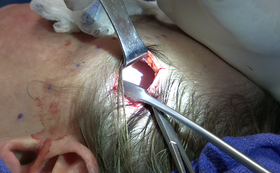| Rhytidectomy | |
|---|---|
 Temporal incision behind the hairline in endoscopic midface lift (rhytidectomy). Note the shiny surface of the deep temporal fascia. This plane is dissected down to the orbital rim and connected to the midface subperiosteal plane created through the sublabial incision under the upper lip, and often through a lower eyelid incision. | |
| ICD-9-CM | 86.82 |
| MedlinePlus | 002989 |
A facelift, technically known as a rhytidectomy (from the Ancient Greek ῥυτίς (rhytis) 'wrinkle', and ἐκτομή (ektome) 'excision', the surgical removal of wrinkles), is a type of cosmetic surgery procedure intended to give a more youthful facial appearance. There are multiple surgical techniques and exercise routines. Surgery usually involves the removal of excess facial skin, with or without the tightening of underlying tissues, and the redraping of the skin on the patient's face and neck. Exercise routines tone underlying facial muscles without surgery. Surgical facelifts are effectively combined with eyelid surgery (blepharoplasty) and other facial procedures and are typically performed under general anesthesia or deep twilight sleep.
According to the most recent American Society for Aesthetic Plastic Surgery facelifts were the third most popular aesthetic surgery in 2019, surpassed only by rhinoplasty and blepharoplasty.[1]
Cost varies by country where surgery is performed. Prices were quoted ranging from US$2,500 (India and Panama) to US$15,000 (United States and Canada) as of 2008[update].[2] Costs in Europe mostly ranged £4,000–£9,000 as of 2009[update].[3]